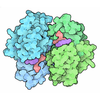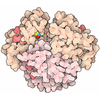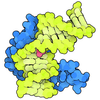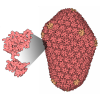[English] 日本語
 Yorodumi
Yorodumi- PDB-9iyd: Cryo-EM structure of an amyloid fibril formed by SOD1 mutant - G93A -
+ Open data
Open data
- Basic information
Basic information
| Entry | Database: PDB / ID: 9iyd | |||||||||||||||
|---|---|---|---|---|---|---|---|---|---|---|---|---|---|---|---|---|
| Title | Cryo-EM structure of an amyloid fibril formed by SOD1 mutant - G93A | |||||||||||||||
 Components Components | Superoxide dismutase [Cu-Zn] | |||||||||||||||
 Keywords Keywords | PROTEIN FIBRIL / Amyloid fibril | |||||||||||||||
| Function / homology |  Function and homology information Function and homology informationaction potential initiation / response to antipsychotic drug / neurofilament cytoskeleton organization / response to carbon monoxide / protein phosphatase 2B binding / dense core granule / relaxation of vascular associated smooth muscle / anterograde axonal transport / regulation of organ growth / response to superoxide ...action potential initiation / response to antipsychotic drug / neurofilament cytoskeleton organization / response to carbon monoxide / protein phosphatase 2B binding / dense core granule / relaxation of vascular associated smooth muscle / anterograde axonal transport / regulation of organ growth / response to superoxide / regulation of T cell differentiation in thymus / positive regulation of oxidative stress-induced intrinsic apoptotic signaling pathway / peripheral nervous system myelin maintenance / retina homeostasis / auditory receptor cell stereocilium organization / hydrogen peroxide biosynthetic process / cellular response to potassium ion / retrograde axonal transport / superoxide anion generation / regulation of GTPase activity / myeloid cell homeostasis / response to copper ion / superoxide metabolic process / muscle cell cellular homeostasis / superoxide dismutase / heart contraction / Detoxification of Reactive Oxygen Species / superoxide dismutase activity / cellular response to ATP / negative regulation of reproductive process / negative regulation of developmental process / cellular response to cadmium ion / transmission of nerve impulse / regulation of multicellular organism growth / ectopic germ cell programmed cell death / response to axon injury / neuronal action potential / ovarian follicle development / positive regulation of superoxide anion generation / axon cytoplasm / glutathione metabolic process / embryo implantation / Gene and protein expression by JAK-STAT signaling after Interleukin-12 stimulation / dendrite cytoplasm / removal of superoxide radicals / reactive oxygen species metabolic process / positive regulation of phagocytosis / response to amphetamine / thymus development / placenta development / positive regulation of cytokine production / regulation of mitochondrial membrane potential / determination of adult lifespan / locomotory behavior / response to nutrient levels / response to hydrogen peroxide / sensory perception of sound / mitochondrial intermembrane space / small GTPase binding / regulation of blood pressure / negative regulation of inflammatory response / peroxisome / Platelet degranulation / protein-folding chaperone binding / response to heat / cytoplasmic vesicle / response to ethanol / spermatogenesis / gene expression / negative regulation of neuron apoptotic process / intracellular iron ion homeostasis / lysosome / positive regulation of MAPK cascade / positive regulation of apoptotic process / mitochondrial matrix / response to xenobiotic stimulus / copper ion binding / neuronal cell body / apoptotic process / protein homodimerization activity / protein-containing complex / mitochondrion / extracellular space / extracellular exosome / extracellular region / zinc ion binding / nucleoplasm / identical protein binding / nucleus / cytoplasm / cytosol Similarity search - Function | |||||||||||||||
| Biological species |  Homo sapiens (human) Homo sapiens (human) | |||||||||||||||
| Method | ELECTRON MICROSCOPY / helical reconstruction / cryo EM / Resolution: 3.09 Å | |||||||||||||||
 Authors Authors | Zhang, M.Y. / Ma, Y.Y. / Wang, L.Q. / Xia, W.C. / Yuan, H.Y. / Zhao, K. / Chen, J. / Li, D. / Zou, L.Y. / Wang, Z.Z. ...Zhang, M.Y. / Ma, Y.Y. / Wang, L.Q. / Xia, W.C. / Yuan, H.Y. / Zhao, K. / Chen, J. / Li, D. / Zou, L.Y. / Wang, Z.Z. / Liu, C. / Liang, Y. | |||||||||||||||
| Funding support |  China, 4items China, 4items
| |||||||||||||||
 Citation Citation |  Journal: EMBO Rep / Year: 2025 Journal: EMBO Rep / Year: 2025Title: Distinct amyloid fibril structures formed by ALS-causing SOD1 mutants G93A and D101N. Authors: Mu-Ya Zhang / Yeyang Ma / Li-Qiang Wang / Wencheng Xia / Xiang-Ning Li / Kun Zhao / Jie Chen / Dan Li / Liangyu Zou / Zhengzhi Wang / Cong Liu / Yi Liang /  Abstract: Two hundred eight genetic mutations in SOD1 have been linked to amyotrophic lateral sclerosis (ALS). Of these, the G93A and D101N variants maintain much of their physiological function, closely ...Two hundred eight genetic mutations in SOD1 have been linked to amyotrophic lateral sclerosis (ALS). Of these, the G93A and D101N variants maintain much of their physiological function, closely resembling that of wild-type SOD1, and the SOD1-G93A transgenic mouse is the most extensively used mouse line in the study of ALS. In this study, we report two cryo-EM structures of amyloid fibrils formed by G93A and D101N mutants of SOD1 protein. These mutations give rise to amyloid fibrils with distinct structures compared to native SOD1 fibrils. The fibril core displays a serpentine configuration featuring four β-strands, held together by two hydrophobic cavities and a salt bridge between Arg143 and Asp96 in the G93A fibril, and by a hydrophobic cavity and a salt bridge between Arg143 and Asp132 in the D101N fibril, demonstrating unique structural features for each mutant. Moreover, our results show that G93A fibrils are significantly more toxic than those formed by D101N, which do not show a marked increase in toxicity compared to wild-type SOD1 fibrils. This study sheds light on the structural mechanisms through which SOD1 mutants aggregate and induce cytotoxicity in ALS. | |||||||||||||||
| History |
|
- Structure visualization
Structure visualization
| Structure viewer | Molecule:  Molmil Molmil Jmol/JSmol Jmol/JSmol |
|---|
- Downloads & links
Downloads & links
- Download
Download
| PDBx/mmCIF format |  9iyd.cif.gz 9iyd.cif.gz | 47.6 KB | Display |  PDBx/mmCIF format PDBx/mmCIF format |
|---|---|---|---|---|
| PDB format |  pdb9iyd.ent.gz pdb9iyd.ent.gz | 31.4 KB | Display |  PDB format PDB format |
| PDBx/mmJSON format |  9iyd.json.gz 9iyd.json.gz | Tree view |  PDBx/mmJSON format PDBx/mmJSON format | |
| Others |  Other downloads Other downloads |
-Validation report
| Summary document |  9iyd_validation.pdf.gz 9iyd_validation.pdf.gz | 1.1 MB | Display |  wwPDB validaton report wwPDB validaton report |
|---|---|---|---|---|
| Full document |  9iyd_full_validation.pdf.gz 9iyd_full_validation.pdf.gz | 1.1 MB | Display | |
| Data in XML |  9iyd_validation.xml.gz 9iyd_validation.xml.gz | 25.9 KB | Display | |
| Data in CIF |  9iyd_validation.cif.gz 9iyd_validation.cif.gz | 35.8 KB | Display | |
| Arichive directory |  https://data.pdbj.org/pub/pdb/validation_reports/iy/9iyd https://data.pdbj.org/pub/pdb/validation_reports/iy/9iyd ftp://data.pdbj.org/pub/pdb/validation_reports/iy/9iyd ftp://data.pdbj.org/pub/pdb/validation_reports/iy/9iyd | HTTPS FTP |
-Related structure data
| Related structure data |  60996MC  9iyjC M: map data used to model this data C: citing same article ( |
|---|---|
| Similar structure data | Similarity search - Function & homology  F&H Search F&H Search |
- Links
Links
- Assembly
Assembly
| Deposited unit | 
|
|---|---|
| 1 |
|
- Components
Components
| #1: Protein | Mass: 15972.782 Da / Num. of mol.: 3 / Mutation: G94A Source method: isolated from a genetically manipulated source Source: (gene. exp.)  Homo sapiens (human) / Gene: SOD1 / Production host: Homo sapiens (human) / Gene: SOD1 / Production host:  Has protein modification | N | |
|---|
-Experimental details
-Experiment
| Experiment | Method: ELECTRON MICROSCOPY |
|---|---|
| EM experiment | Aggregation state: HELICAL ARRAY / 3D reconstruction method: helical reconstruction |
- Sample preparation
Sample preparation
| Component | Name: ALS-causing SOD1 mutant G93A / Type: ORGANELLE OR CELLULAR COMPONENT / Entity ID: all / Source: RECOMBINANT |
|---|---|
| Source (natural) | Organism:  Homo sapiens (human) Homo sapiens (human) |
| Source (recombinant) | Organism:  |
| Buffer solution | pH: 7.4 |
| Specimen | Embedding applied: NO / Shadowing applied: NO / Staining applied: NO / Vitrification applied: YES |
| Vitrification | Cryogen name: ETHANE |
- Electron microscopy imaging
Electron microscopy imaging
| Experimental equipment |  Model: Titan Krios / Image courtesy: FEI Company |
|---|---|
| Microscopy | Model: FEI TITAN KRIOS |
| Electron gun | Electron source:  FIELD EMISSION GUN / Accelerating voltage: 300 kV / Illumination mode: FLOOD BEAM FIELD EMISSION GUN / Accelerating voltage: 300 kV / Illumination mode: FLOOD BEAM |
| Electron lens | Mode: BRIGHT FIELD / Nominal defocus max: 2000 nm / Nominal defocus min: 1200 nm |
| Image recording | Electron dose: 60 e/Å2 / Film or detector model: GATAN K3 (6k x 4k) |
- Processing
Processing
| EM software | Name: PHENIX / Version: 1.15.2_3472: / Category: model refinement | ||||||||||||||||||||||||
|---|---|---|---|---|---|---|---|---|---|---|---|---|---|---|---|---|---|---|---|---|---|---|---|---|---|
| CTF correction | Type: PHASE FLIPPING AND AMPLITUDE CORRECTION | ||||||||||||||||||||||||
| Helical symmerty | Angular rotation/subunit: -0.73 ° / Axial rise/subunit: 4.88 Å / Axial symmetry: C1 | ||||||||||||||||||||||||
| 3D reconstruction | Resolution: 3.09 Å / Resolution method: FSC 0.143 CUT-OFF / Num. of particles: 57507 / Symmetry type: HELICAL | ||||||||||||||||||||||||
| Refine LS restraints |
|
 Movie
Movie Controller
Controller



 PDBj
PDBj







